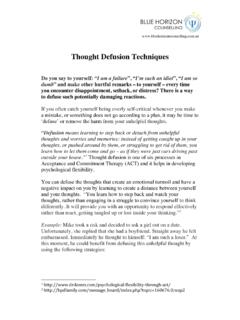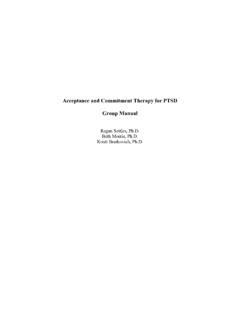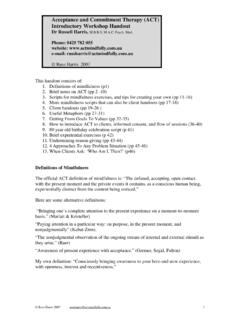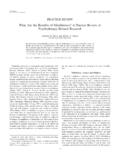Transcription of Evaluating Acceptance and Commitment Therapy: An …
1 IJBCT Consolidated Volume 5, No. 3 & 4 311 Evaluating Acceptance and Commitment therapy : An Analysis of a Recent Critique Brandon A. Gaudiano, Department of Psychiatry & Human Behavior, Alpert Medical School of Brown University Psychosocial Research Program, Butler Hospital Abstract Acceptance and Commitment therapy (ACT) is a newer psychotherapy that has generated much clinical and research interest in recent years. However, the approach has begun to receive strong criticism from proponents of traditional cognitive-behavioral therapy (CBT).
2 Hofmann and Asmundson (2008) recently compared and contrasted ACT and traditional CBT. They concluded that ACT s criticisms of traditional CBT are inaccurate; both ACT and CBT can be understood using a similar theoretical model; and there is no evidence that ACT represents a third wave of behavior therapy , as is sometimes claimed by its proponents. In the current article, I further analyze Hofmann and Asmundson s critique of ACT to determine its evidential merit and to attempt to clarify potential points of misunderstanding between CBT and ACT proponents. Keywords: Acceptance and Commitment therapy , cognitive behavior therapy , psychotherapy research Acceptance and Commitment therapy (ACT) is a novel Acceptance /mindfulness-based behavioral treatment that has been increasing in popularity in recent years.
3 A detailed description of ACT theory and technique is beyond the scope of the current article, and thus it will only be summarized briefly here. Readers are referred to other books and articles that provide more detailed descriptions (Hayes, 2004a, 2004b; Hayes, Barnes-Holmes, & Roche, 2001; Hayes, Luoma, Bond, Masuda, & Lillis, 2006; Hayes & Strosahl, 2004; Hayes, Strosahl, & Wilson, 1999). ACT stems from a philosophy of radical behaviorism. The approach itself is rooted in a specific theoretical model, called Relational Frame Theory (RFT) (Hayes et al., 2001), which was developed to provide an updated behavior analytic account of language that expands upon the previous work of B.
4 F. Skinner. In general, ACT can be described as combining Acceptance and mindfulness strategies with overt behavior change efforts to improve what its creators call psychological flexibility (Hayes et al., 1999). psychological flexibility is defined as the ability to contact the present moment more fully as a conscious human being, and to either change or persist when doing so serves valued ends (Hayes, Strosahl, Bunting, Twohig, & Wilson, 2004, p. 5). In other words, healthy psychological functioning is proposed to be related to a person s ability to adaptively respond to changing environmental contingencies. In contrast, psychological inflexibility or rigidity is theorized to be the result of what ACT calls cognitive fusion and experiential avoidance.
5 Cognitive fusion is defined as the tendency of human beings to live in a world excessively structured by literal language (Strosahl, Hayes, Wilson, & Gifford, 2004, p. 39). For example, when a person is fused with a thought ( I am depressed ), he/she is experiencing that thought literally ( I = depression ). This cognitive fusion permits the literal content of thinking to dominate over a person s behavior ( I can t go to work today because I am depressed ). Cognitive fusion also fosters experiential avoidance, which is defined as the attempt to escape or avoid the form, frequency, or situational sensitivity of private events, even when the attempt to do so causes psychological harm (Hayes et al.)
6 , 2004, p. 27). When engaged in experiential avoidance, the person attempts to avoid or suppress undesirable private material such as thoughts, memories, emotions, and bodily sensations as if they were inherently harmful, even though doing so can paradoxically worsen these problems in the long-run (Wenzlaff & Wegner, 2000). The co-processes of fusion and experiential avoidance result in the narrowing of a person s behavioral repertoire ( , psychological inflexibility), which is believed to lead to and maintain a wide spectrum of psychopathological behaviors. ACT targets six core processes for IJBCT Consolidated Volume 5, No.
7 3 & 4 312 psychological flexibility : promoting Acceptance of distressing internal experiences, fostering cognitive de-fusion so the literal content of thought does not dominate over a person s behavior, practicing awareness of ongoing experience in the present moment, establishing a stable sense of self that is broader than merely its evaluative content, developing personal valued life directions to guide behavior, and committing to actions that are consistent with these personally chosen values. Various psychotherapeutic techniques, many of which are inspired by or borrowed from other approaches to psychotherapy ( , humanistic, gestalt), are used to address psychological inflexibility.
8 In particular, ACT makes heavy use of metaphors, logical paradoxes, and experiential exercises, as well as more traditional behavioral techniques ( , behavioral activation, exposure). The goal of these strategies is to improve psychological flexibility by fostering Acceptance of internal states of distress and cognitive defusion from problematic language-based processes. Initial research on ACT suggests that: (1) psychological inflexibility is related to diverse indices of psychopathology as predicted. (2) ACT has been shown to be potentially efficacious for a variety of clinical conditions based on preliminary trials. (3) Many of the specific components of ACT show initial evidence of efficacy in experimental studies.
9 (4) ACT appears to work at least partly through its hypothesized mechanisms of action; although formal statistical mediation has only been demonstrated in a few studies to date (Hayes et al., 2006). The aforementioned research is in addition to numerous experimental studies conducted to date that separately lend support for RFT, the underlying basic science research program that relate to the clinical application of ACT (Hayes et al., 2001). The ACT studies conducted to date lend support for many important aspects of the approach, but most represent small pilot studies that have methodological limitations. Thus, independent replication trials using larger samples will be necessary to confirm these initial promising findings.
10 However, the evidence to date appears moderately strong in support of ACT at this stage of investigation. Recent meta-analyses of ACT outcomes conducted in a wide-range of clinical populations indicate medium to large effect size differences versus comparison conditions (Hayes et al., 2006; st, 2008; Powers, Zum V rde Sive V rding, & Emmelkamp, 2009), which is consistent with the broader CBT literature. Contrary to some authors claims to the contrary regarding ACT s empirical status (see st, 2008), the American psychological Association s Division 12 (Clinical Psychology) recently included ACT for depression on its list of empirically-supported treatments, concluding that it has moderately strong empirical support based on published clinical The increasing popularity of ACT in recent years has begun to draw the attention and scrutiny of proponents of traditional cognitive-behavioral therapy (CBT), many of whom have expressed skepticism about the approach.














